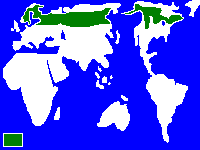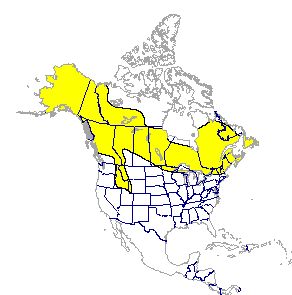 Moose also appear in northern parts of Europe (Scandinavia, Russia) and Asia (Siberia, Mongolia, Northern China). The green areas on the world map on the left represent the full global coverage.
Moose also appear in northern parts of Europe (Scandinavia, Russia) and Asia (Siberia, Mongolia, Northern China). The green areas on the world map on the left represent the full global coverage.

 Moose also appear in northern parts of Europe (Scandinavia, Russia) and Asia (Siberia, Mongolia, Northern China). The green areas on the world map on the left represent the full global coverage.
Moose also appear in northern parts of Europe (Scandinavia, Russia) and Asia (Siberia, Mongolia, Northern China). The green areas on the world map on the left represent the full global coverage.
In the Middle Ages, moose also lived in the vast forests of central and western Europe but have sadly since become extinct.
Within the current areas, moose are mostly found in sparesly wooded areas of mixed or deciduous trees, near lakes or rivers.
830,000 Canadian moose !!!
435,000 Russian moose !!!
255,000 American moose !!
200,000 Swedish moose !!
125,000 Norwegian moose !
90,000 Finnish moose !
But as far as I know this Englishman lives in a land with no moose at all. :O(
Conservation status currently stands at "Lower Risk".
Wildlife experts have been studying the wolf/moose relationship at Isle Royale National Park, a wilderness island in the middle of Lake Superior on the border between Canada and America. These isolated populations provide an ideal natural laboratory for study without the influence of man.
The moose population appeared on the island in the early 1900s and with the abscence of any predators the population continued to grow to a peak in the 1930s when there were over 5 moose per 100 hectares. Later in the early 1950s a group of wolves crossed the ice to the island and the population of moose began to decrease. Obviously the moose were in a weakened state due to the over population since a moose is a match for any wolf. Soon after the two populations existed in perfect equilibrium.
Now each spring a scientist called Dr. Rolf Peterson publishes an annual report detailing the study of population levels and factors on Isle Royale which are effecting the habitat.
Tree ring studies of forest trees, heavily browsed by moose, have revealed that tree growth in the regenerating forest declined in line with the moose increase. The question becomes, how many moose can the habitat support? Will the moose eat themselves out of a home.
The current wolf population of Isle Royale is very young. Eleven wolves are less than four years old and ample numbers of males and females are ready to assume alpha positions in the packs, which permits reproduction. Recently only one of the three packs reproduced yielding two pups. Dr. Peterson said, "If the next generation of wolves reproduces at rates similar to the last, then genetic decay will probably remain the only reasonable explanation for low productivity, preventing expansion of the wolf population."
... or return home.